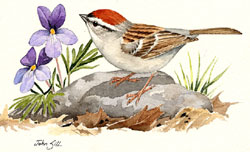Breeding Bird Atlases (BBA)
Find a Bird - BBA1
Breeding Bird Atlas 1 Species Accounts
Chipping Sparrow
Spizella passerina
Egg Dates
May 5 to June 26
Number of Broods
one or two

The Chipping Sparrow is a common summer resident throughout most of the state. Because of this species’ affinity for open and semiopen habitats, it is assumed that more optimum conditions existed during the period of maximum clearing, i.e., during the midnineteenth century, and that there has been some decline in the relative abundance of the Chipping Sparrow over the last century. However, the gradual creation of more and more suburban areas during the last three decades with their parklike aspect of grassy lawn and ornamental conifers has created favorable habitat. The chippy also sometimes frequents open woods or forest borders. It is less common at the higher altitudes of Worcester and Berkshire counties and is absent from heavily forested areas.
Chipping Sparrows depart from their southern coastal-plain wintering grounds in early spring, and, although occasional birds turn up here in early April, territorial residents as well as transients generally are noted between mid-April and mid-May. Breeding birds are found commonly around suburban residences, golf courses, and rural farmland.
The male chippy is an energetic and persistent, if somewhat limited, songster. As its name implies, the song of this species is an uninterrupted string of chips. These are usually given at a rate fast enough to create a trill. Although the pitch and speed may vary, each phrase is normally steady, unvarying, and monotonous. A high tsip alarm note may be given about the nest, and a twittering conversational call is heard frequently.
Males advertise their presence by singing from elevated perches. During courtship, they intersperse bouts of singing with quick flights to the ground near a female. Favored nest sites include shrubs and trees, particularly evergreens, about dwellings, and orchards. Locations of 22 Massachusetts nests were cemetery (3 nests), yard (7 nests), hedge (3 nests), woods (6 nests), field (3 nests) (CNR). Twenty-six state nests were situated as follows: unspecified conifer (6 nests); Arbor Vitae (2 nests); pines, including Red, Scotch, and White (7 nests); Red Cedar (5 nests); Norway Spruce (3 nests); barberry (1 nest); apple (1 nest); unspecified deciduous tree (1 nest) (CNR). Heights ranged from 1 to 19 feet and averaged 7 feet (CNR).
Females build a tightly constructed nest consisting of dried grasses and rootlets. The fact that the entire structure may be lined with horsehair indicates that this species has close ties to the environs of people. The clutch size is normally four eggs. For 19 state nests clutch sizes were three eggs (4 nests), four eggs (14 nests), five eggs (1 nest) (CNR, DKW, ACB). Incubation is by the female alone for a period of 11 to 14 days, and during this time the male feeds her at the nest. Both parents feed the young, and the female broods them for several days. At 7 days of age, the young are well feathered and they usually fledge in 9 to 10 days. In Massachusetts, nestlings have been recorded from May 14 to July 20. Known fledge dates were June 10, 14, 18 and 22, and July 9 (CNR). Brood sizes for 14 state nests were one young (1 nest), two young (4 nests), three young (3 nests), four young (6 nests) (CNR). Fledged, dependent young have been observed here from June 10 to August 14 (CNR, Meservey), but some earlier dates would be expected. Fledglings follow a parent and beg for food with a constant zip-ip-zip-ip-zip-ip series of notes. Two broods per season are usual. During the latter part of the summer, family groups are often observed together. Adults and young complete their molts at the end of the nesting season.
Flocks of migrant Chipping Sparrows are common during the period from early Septem- ber to late October, when they are found in weedy fields and other waste areas. By mid-November, most chippies have moved out of our area to wintering grounds in the southern states. Overwintering individuals are rare, but their presence is noted annually.
Map Legend and Data Summary
Atlas 1 data collected from 1975-1979


Note: common along roadsides and in fields and residential areas throughout the state
Richard K. Walton



